Alienware M14x: the Sound and the Fury
by Dustin Sklavos on July 19, 2011 12:35 AM ESTApplication and Futuremark Performance
At this point the Intel Core i7-2630QM at the center of the Alienware M14x is largely a known quantity, but in the 14" notebook class things are different, with quad-core processors being more rarefied. Most of our 14" notebook reviews are from the Arrandale era, but we do have a couple of Sandy Bridge notebooks thrown into the mix to give you an idea of how performance has changed, and we've also got the sample AMD Llano A8 system.


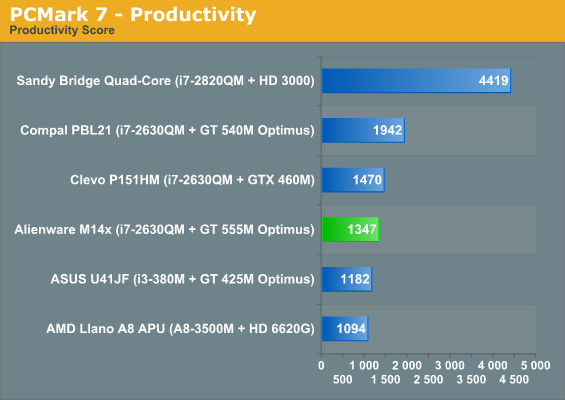

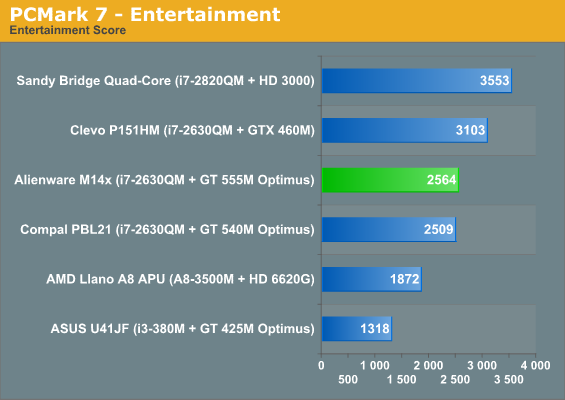
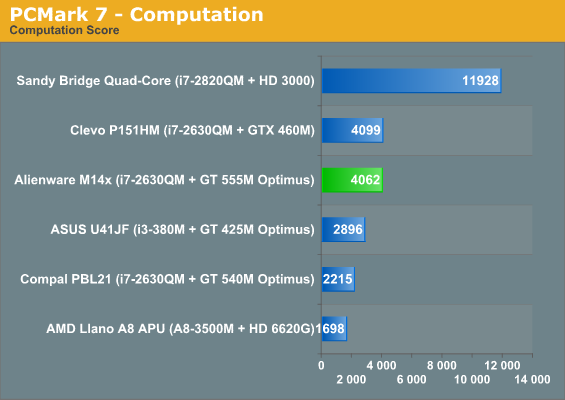
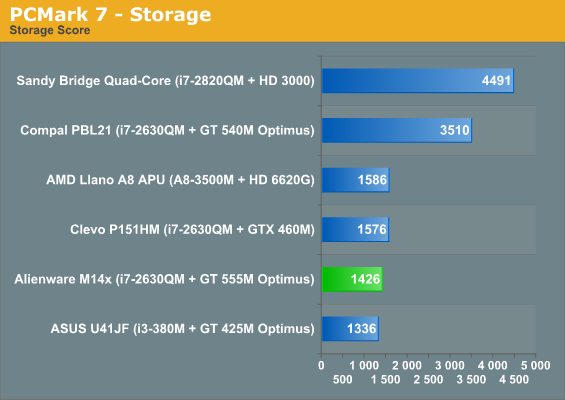
Where possible the SSD-equipped Compal PBL21 and Sandy Bridge quad-core reference system get a comfortable lead, proving that PCMark still skews heavily towards SSDs even in its most recent version. The storage benchmark is particularly brutal, suggesting the Samsung hard drive the M14x ships with may not be as fast as its counterparts from Seagate and Western Digital. Overall, though, the M14x hangs out in the middle of the pack, about where it ought to be.
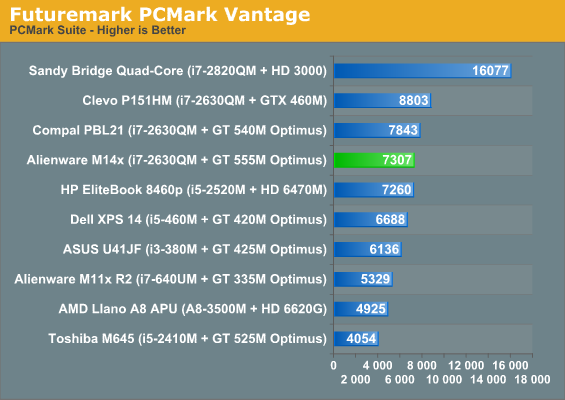
For some reason, PCMark Vantage doesn't favor the SSD-equipped Compal PBL21 as heavily in our lineup, while Sandy Bridge continues to be a monster, both as a processor and as a reference platform.
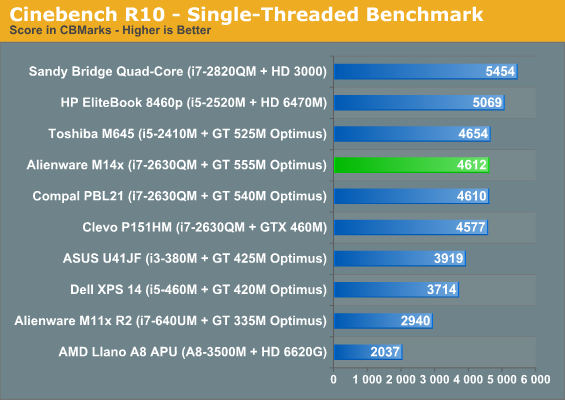
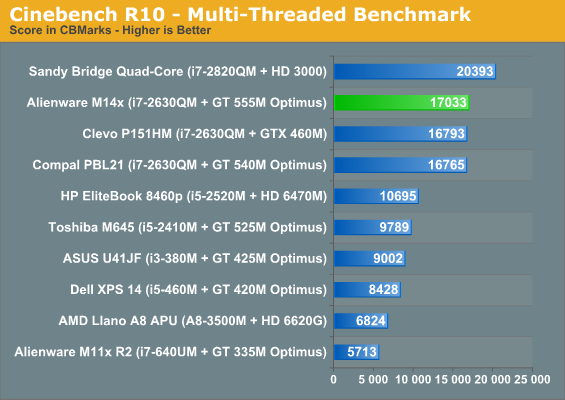
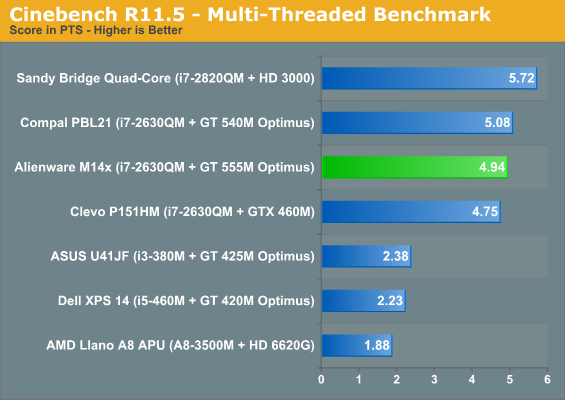
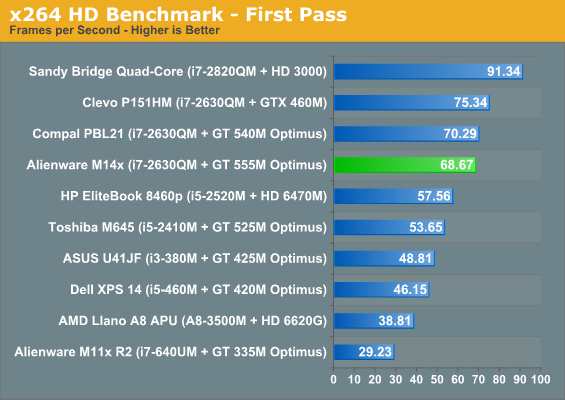
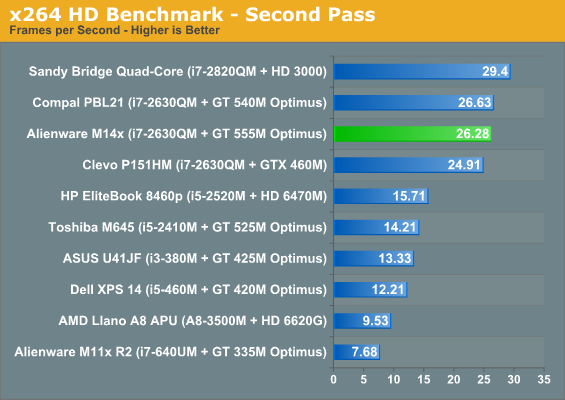
The beauty of Cinebench is how repeatable and consistent its test results are, and the Alienware M14x falls in exactly where it ought to be. Our x264 encoding test tells much the same story, one you already knew: the i7-2630QM is mighty fast. Where things get interesting is when you look at how much of a performance boost the i7-2630QM brings for the M14x against competing 14" notebooks that are only able to leverage dual-core processors. While Arrandale and Clarksfield would often compete directly against each other, Sandy Bridge quad-cores produce a clear and consistent performance advantage over their dual-core counterparts.
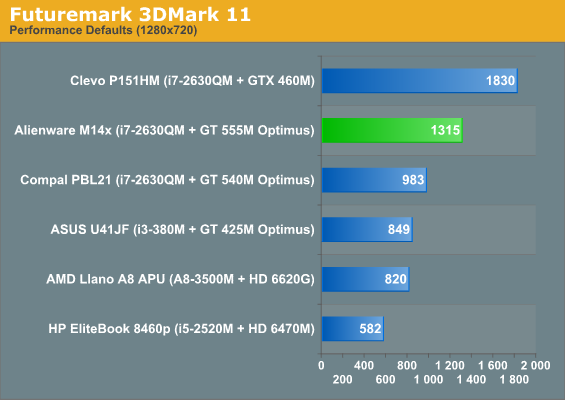
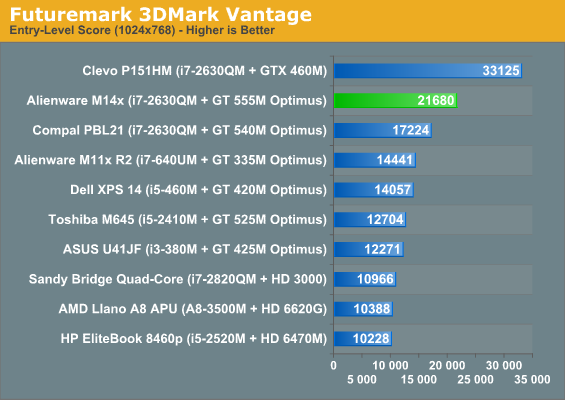
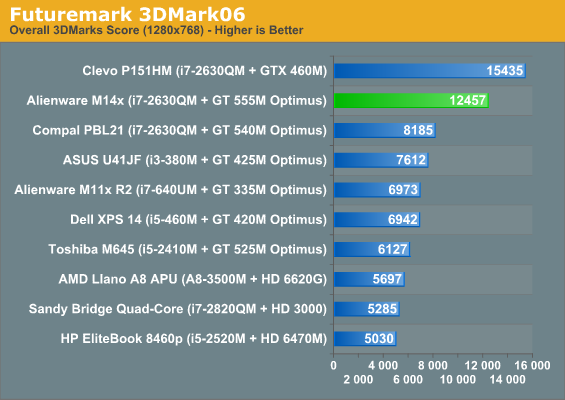
Finally in 3DMark, the 144-shader NVIDIA GeForce GT 555M offers a substantial performance improvement over the 96-shader GT 540M and its kin, bested only by the more powerful GTX 460M. Keep in mind the form factor that the GT 555M is residing in, because this is pretty much the fastest chip you can conceivably fit in a 14" laptop.










48 Comments
View All Comments
cknobman - Tuesday, July 19, 2011 - link
Hmm Sony C' series laptops are 14' with 1600x900 panels and offer ATI 6630 graphics in them.Last year I bought the CW series before they discontinued them which was a 14' 1600x900 panel and came with Nvidia 330m graphics.
There are other (and cheaper) options out there besides dellienware.
etamin - Tuesday, July 19, 2011 - link
A couple friends asked me to look into a few portable laptops for them the past week and I spent some time looking for hi-res options on 14" models. The only other notebook I found with a 1600x900 screen was the HP Elitebook 8460p which, in my opinion, is the best business notebook for $1500. It's absurd that most vendors stop at 1366x768 even on their 15.6" models.lunarx3dfx - Tuesday, July 19, 2011 - link
I bought mine on release day, and I love it. At the time that I ordered mine the i5 wasn't even an option cpu wise, but I have found that if you keep the GPU in check (aka don't use it when not needed) the fan noise isn't bad at all. On my unit the fan usually only runs for a few seconds at a time unless I'm gaming, and I haven't noticed the laptop getting all that hot. I agree that the cooling could definitely be better.Also, on the issue of media playback. I'd be willing to bet that the GPU was kicking in automatically. By default the optimus settings use the GPU for media players. I went in and set mine to use the Intel GPU, and my media playback battery life went to well over 3 hours.
Just a suggestion. To the person that mentioned nvidia's drivers not working, you are right. However, it took them a little while to support the m11x R2 after its release as well. Just give it time and they will add support. Until then, modded inf's aren't hard to find.
All in all, I thoroughly enjoy my m14x, and I'm glad that someone finally stated what I stated in my video review of the m14x on youtube about the memory options for the GPU. I've gotten flamed quite a bit there because I said that the 3 GB option was excessive and not necessary, and would provide no performance improvement.
Thanks again, for a great review.
StrangerGuy - Tuesday, July 19, 2011 - link
Easy. Replace the useless internal optical drive with another HSF. Problem solved.I'm not even sure why they want to squeeze in an ODD in an laptop intended for pure GAMING performance. What a dumb decision.
Wolfpup - Tuesday, July 19, 2011 - link
I still don't like the looks on these things-wish you could just get them boxy. The M15x had defective audio-either out of the box, or often within a year.Hopefully that's fixed on this...but it has Floptimus and a mid-range GPU... If it looked more normal, and didn't use Floptimus, they'd have something...
lunarx3dfx - Tuesday, July 19, 2011 - link
What's wrong with optimus? It does exactly what it's supposed to do very well. Also, how would you expect them to fit a high end GPU into a package that small? The purpose of the m14x is to meet those of us who want a portable laptop that can still play games. For that it works very well.aguilpa1 - Tuesday, July 19, 2011 - link
Regardless whether you want portable or not, when a "GT" 555M can't even outperform an ancient 460M there is a HUGE problem with the industry as a whole.JarredWalton - Tuesday, July 19, 2011 - link
The 400M and 500M series are essentially equal, so you "ancient 460M" isn't really that old -- I first tested the 460M in November last year, so it's perhaps nine months old now. (http://www.anandtech.com/show/3998/)The second problem is that the GT line has always been the slower (mainstream) line from NVIDIA, while the GTX is for the enthusiast/high performance sector. So, it's really no surprise at all that the fastest current "mainstream" part is slower than the previous generation (aka, "not-speed-bumped") "enthusiast" part. It's like saying it's a HUGE problem that the GT 555M isn't faster than the GTX 560M; it's not supposed to be. If the GT 555M was slower than the GT 445M, then we'd have something to complain about. Not that the memory configuration and different core types isn't a big enough issue with the GT 555M!
GeorgeH - Tuesday, July 19, 2011 - link
Please. Next you're going to be telling us that the brand new GT520 is a lot slower than the ancient GTX480. And don't even get me STARTED on the MX460/GTX460 flotilla of LIES and ICE CREAM.Damn you, industry! Damn you to Hades!
FH123 - Tuesday, July 19, 2011 - link
Dustin, you wrote: "The 1600x900 resolution is frankly vastly preferable to the dire 1366x768 resolution invariably employed by notebooks in the 14" class. 1366x768 is just cramped, and on a 15" notebook it's an eyesore."I wonder could you not make such blanket statements about high resolution. I completely agree with complaints about poor contrast in todays screens and am glad you're hammering that message home every chance you get. However high DPI is a problem for some of us with less good eye-sight. Windows was designed in an era of 90dpi screens and this still shows. Even with Windows 7 I frequently run across text in some software, some Windows screen or some web-site that won't scale or is blurry as a result. As long as this is the case, high DPI is a strain for me. I particularly take issue with your use of the word "eyesore", as this word applies completely the other way round in my case. It's the high DPI screens that cause my eyes to be sore. As these are normally the premium screens that also have at least half-decent contrast, I am caught between a rock and a hard place. Going with a poor contrast low DPI screen or a good contrast high DPI screen is a toss-up for me. What I really want is a good contrast low DPI screen. Windows 8 looks to change the UI experience yet again, but be under no illusion that it still needs to run all the legacy stuff out there, so I don't see this situation changing for many years yet.
By the way I have a driving license and naturally had to pass an eye test for that. I do not consider myself disabled and I can work with high DPI screens, if I have to. I simply prefer high contrast, low DPI screens. Going back to my old 4:3, XGA 14" notebook or 19" 1280x1024 (86dpi, PVA) desktop screen is always a relief.